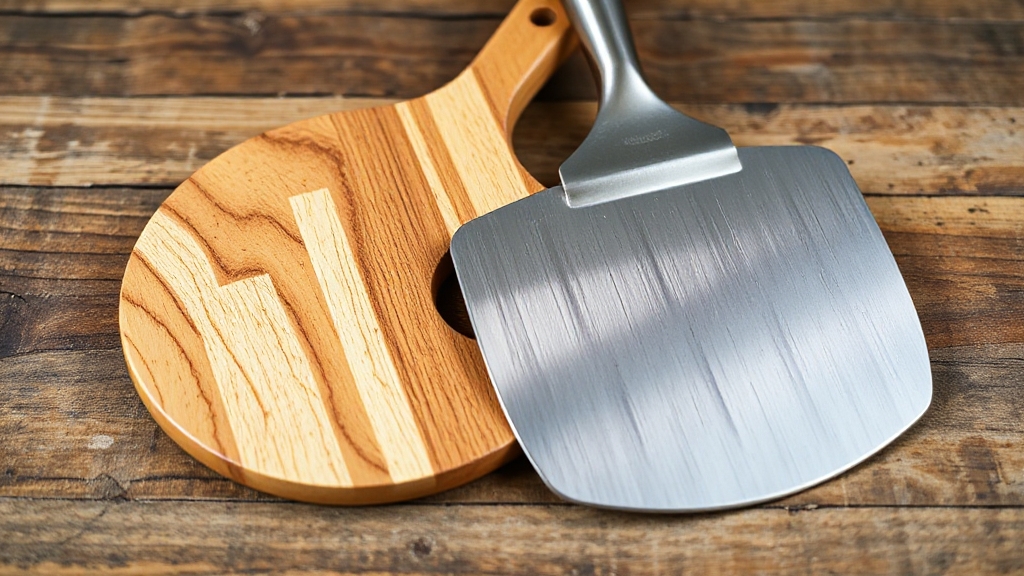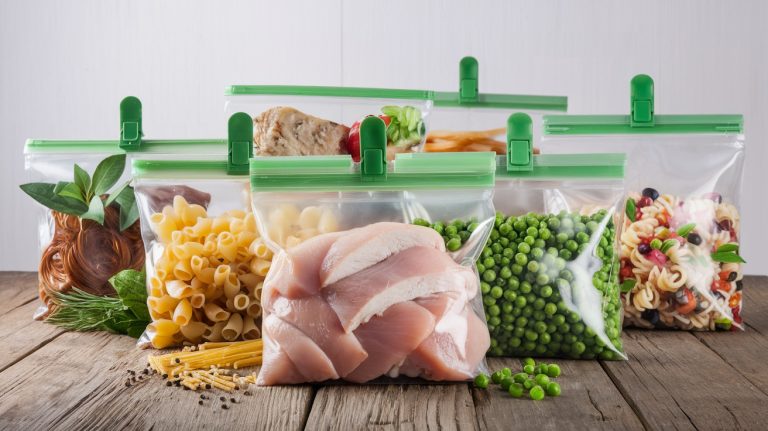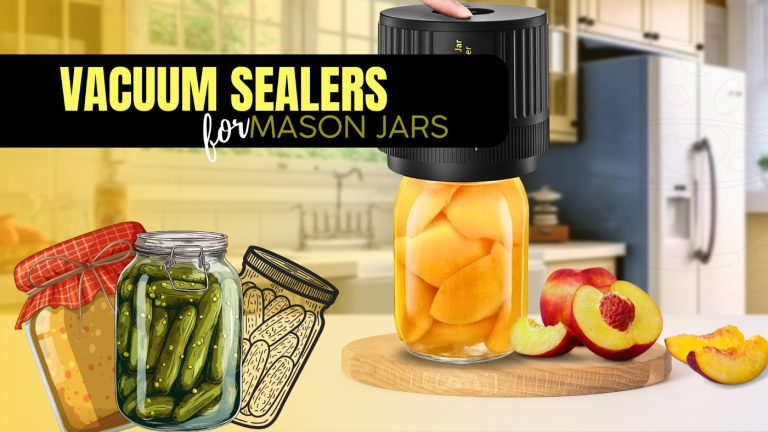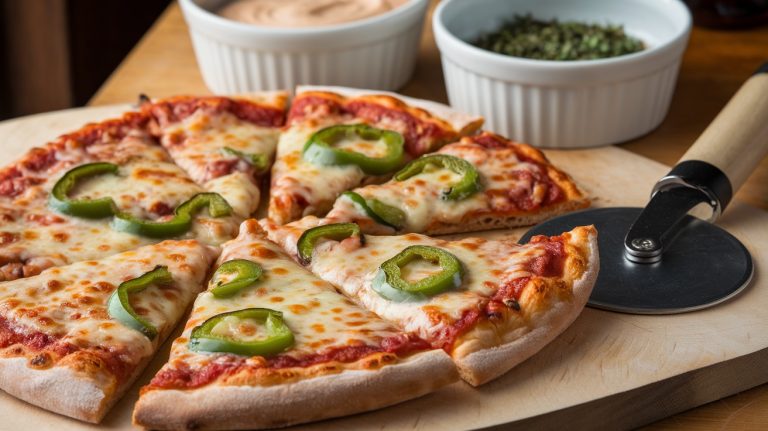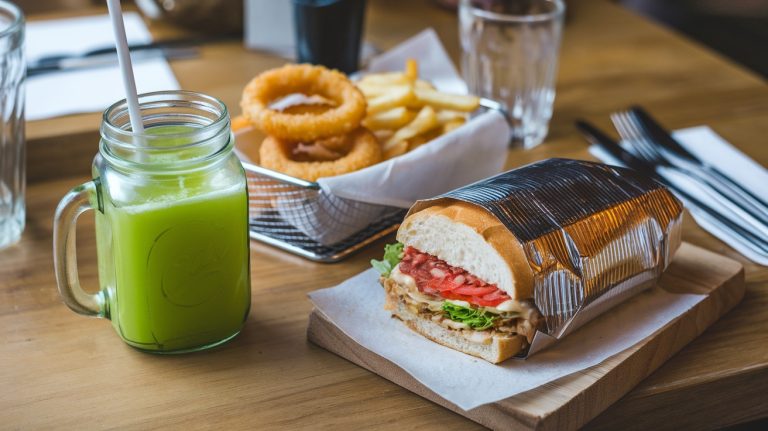Pizza Peel Wood vs Metal: Choose the One That Fits Your Style
When choosing between a wooden and metal pizza peel, consider how you handle dough and oven tasks. Wooden peels are thicker, heavier, and slightly textured, helping prevent sticking and offering sturdy grip for launching raw dough.
Metal peels are thinner, lighter, and smooth, making it easier to slide baked pizzas in and out of hot ovens. You’ll want to balance durability, ease of maintenance, and dough management—exploring these factors can help you pick the perfect peel for your pizza craft.
- 【Storage Bag Included】: We have specially equipped a storage bag In order to provide a variety…
- 【Healthy High Quality Metal Aluminum】:The metal pizza paddle is made of high quality grade…
- 【Easy to use】:Wooden pizza peel boards are prone to splintering and are not resistant to…
- Sturdy, durable, and lightweight basswood with a fine, even texture ensures our peels are less prone…
- Wood peels feature a tapered half-inch blade designed to easily slide under, and lift pizza from a…
- Smooth even texture keeps peels free of secreting oils that make their way into your food,…
Key Takeaways
- Wooden peels are thicker and heavier, providing sturdy handling but causing user fatigue during extended use.
- Metal peels are thinner and lighter, allowing smoother, more precise pizza sliding and retrieval.
- Wooden peels’ porous surface reduces dough sticking, ideal for launching raw pizzas into the oven.
- Metal peels resist warping, are easier to clean, and are better suited for removing baked pizzas.
- Wood requires careful maintenance to prevent warping and bacterial buildup, while metal offers superior hygiene and durability.
Comprehensive Comparison Table Between Wooden and Metal Pizza Peels
| Feature | Wood Pizza Peel | Metal Pizza Peel |
|---|---|---|
| Thickness | Thicker (0.5 to 2 cm) – provides sturdy base | Thinner (0.25 to 0.75 cm) – allows delicate sliding |
| Weight | Heavier – more substantial feel, can cause fatigue | Lighter – more agile, reduces fatigue during use |
| Surface Texture | Porous and textured – naturally reduces sticking | Smooth and slick – prone to dough sticking |
| Best Use Case | Launching raw dough into oven – ideal for prep | Retrieving baked pizzas from oven – excellent for removal |
| Dough Release | Excellent – porous surface grips dough, prevents sticking | Challenging – requires generous flour dusting |
| Heat Resistance | Good insulation, cooler handles | Heat-resistant, can get hot to touch |
| Durability | More fragile – prone to warping, cracking, moisture absorption | Highly durable – resists warping, impact damage |
| Maintenance | High maintenance – hand wash only, requires food-safe oil treatment | Low maintenance – dishwasher safe, easy cleaning |
| Hygiene | Porous surface can trap bacteria, requires vigilant cleaning | Non-absorbent surface resists microbial growth |
| Edge Design | Thicker edge – harder to slide under cooked pizza | Thin edge – gracefully slides under pizzas |
| Handling | Ergonomic grip – better leverage for rotating pies | Lightweight and maneuverable – precise movements |
| Food Safety | Can absorb moisture and odors, potential contamination risk | Smooth surface – easier sanitation, no absorption |
| Aesthetic | Rustic, traditional appearance – serving-friendly | Sleek and functional – modern look |
| Storage | Bulkier – harder to store due to thickness | Slim profile – easier storage |
| Cost | Generally less expensive initially | Typically more expensive upfront |
| Longevity | Requires replacement due to wear and warping | Longer lasting with proper care |
| Temperature Sensitivity | Can warp or crack with extreme temperature changes | Stable under high heat conditions |
| Flour Requirements | Light dusting sufficient due to porous surface | Generous dusting needed to prevent sticking |
Thickness, Weight and Handling Differences
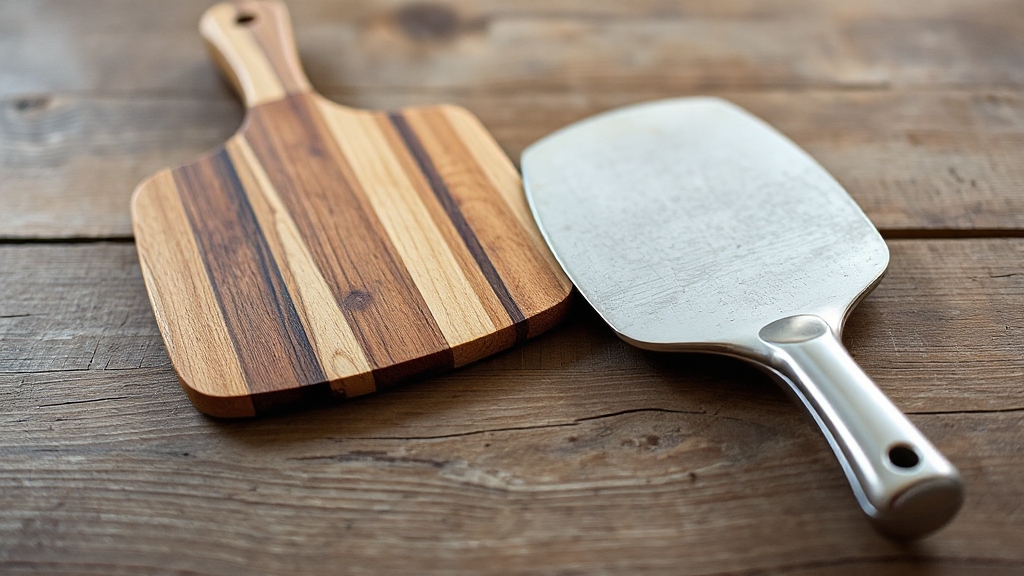
While wooden and metal pizza peels serve the same purpose, their differences in thickness and weight considerably affect how you handle them. Wooden peels are thicker—ranging from 0.5 to 2 cm—giving you a sturdy base but requiring a swift, forceful scoop to avoid shifting your pizza.
They often feature a thicker edge which can make sliding under dough more challenging. Their sturdy nature provides better grip and leverage, similar to how heavier mixes can impact bread texture.
Wooden pizza peels are thicker and sturdy but need a quick, firm scoop to keep your pizza steady.
Metal peels, much thinner at 0.25 to 0.75 cm, let you slide under pizzas delicately, making retrieval smoother and less disruptive. Weight plays a role too: wooden peels feel heavier and more substantial, which can tire you during long baking sessions but offer better grip and leverage for rotating pies.
Metal peels are lighter and more agile, reducing fatigue and allowing precise movements. Choosing the right peel is like selecting the proper mix; understanding texture and rising problems can help you achieve the best results.
Your choice depends on how much finesse or sturdiness you want while maneuvering your pizza in the oven.
Dough Release and Sticking Considerations
Because dough tends to stick differently depending on the peel material, understanding how wood and metal interact with your pizza dough can save you frustration in the kitchen.
Wooden peels, with their porous, slightly textured surface, naturally reduce sticking and grip dough just enough to keep it stable while topping. Their insulating properties help maintain dough temperature, preventing condensation that causes sticking. Dusting lightly with flour or semolina usually suffices on wood. However, wooden peels can develop splinters, which may pose food safety concerns if not properly maintained.
Metal peels, however, have smooth, slick surfaces that often cause dough to stick, especially when warm dough meets a cold peel, creating moisture buildup. You’ll need to dust metal peels more generously and act quickly to slide dough off.
Using wood for launching and metal for retrieving balances dough release and sticking challenges effectively.
Durability and Maintenance Requirements
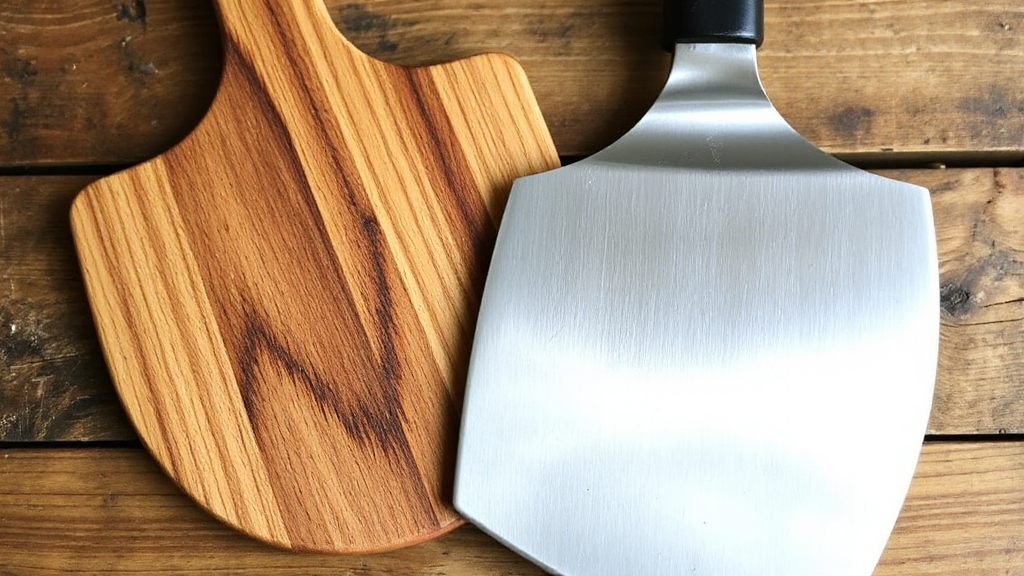
Although both wood and metal pizza peels serve the same essential function, their durability and upkeep differ markedly, affecting how you care for and use them over time.
Wooden peels are more fragile, prone to warping, cracking, and absorbing moisture, which can lead to odors and sanitation issues. You’ll need to hand wash them gently, dry thoroughly, and regularly treat them with food-safe oils to prevent drying and splitting.
Additionally, wooden peels are porous and require the use of flour or cornmeal to prevent pizzas from sticking during transfer. Proper maintenance ensures the wood remains hygienic and extends its functional life, similar to how material durability is crucial in baking tools.
In contrast, metal peels—especially stainless steel—offer greater durability and resist warping or impact. They’re easier to maintain since most are dishwasher safe and don’t absorb moisture or odors. You’ll just need to inspect for dents occasionally, but overall, metal peels demand less effort and last longer, making them a resilient choice for frequent pizza making.
Optimal Use Cases for Wood and Metal Peels
When you’re choosing between wood and metal pizza peels, understanding their ideal use cases can elevate your pizza-making experience. Wood peels excel at handling raw, delicate doughs thanks to their porous surface, which reduces sticking and prevents damage.
They also require regular maintenance with food-safe oil to keep them in good condition and prevent warping. Maintaining the surface properly can extend the peel’s lifespan and improve performance by reducing dough adhesion through its porous texture. Metal peels shine when sliding fully cooked pizzas in and out of high-heat ovens, thanks to their heat resistance and slim design.
| Feature | Wood Peel | Metal Peel |
|---|---|---|
| Best for | Raw, thin-crust dough | Fully baked pizzas |
| Surface | Porous, moisture-absorbing | Smooth, cold surface |
| Oven use | Prep peel, cooler handles | Oven peel, heat-resistant |
| Handling | Ergonomic, non-slip grip | Lightweight, maneuverable |
| Aesthetic | Rustic, serving-friendly | Sleek, functional |
Hygiene and Food Safety Factors
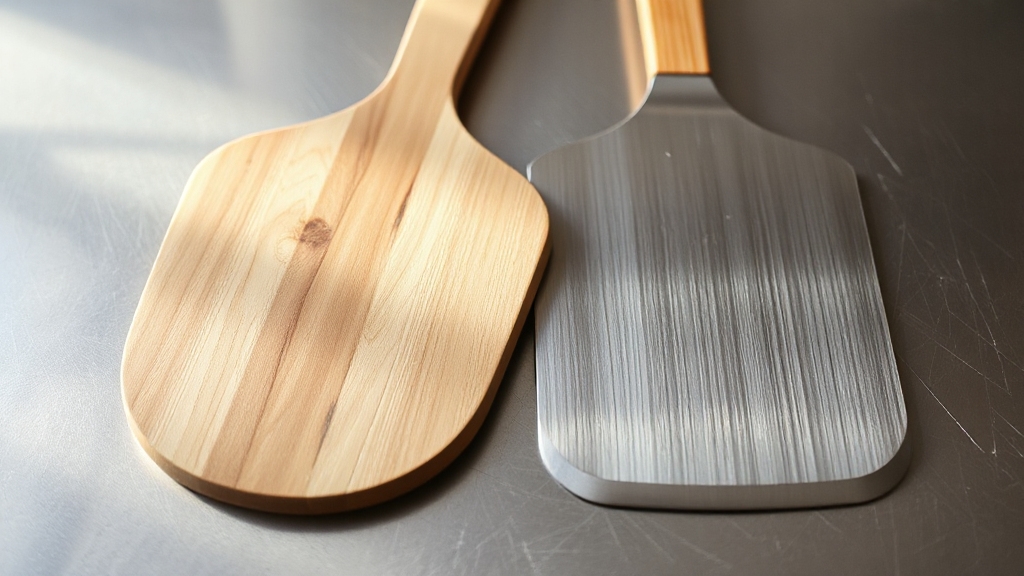
While choosing between wood and metal pizza peels, you’ll want to weigh how their materials impact hygiene and food safety. Wood’s porous surface can trap moisture, bacteria, and allergens, requiring vigilant cleaning and drying to prevent contamination. This is similar to how starter maintenance is crucial in baking Herman sourdough to ensure the culture remains healthy and uncontaminated.
Metal peels, especially stainless steel, offer smooth, non-absorbent surfaces that resist microbial growth and simplify sanitation. Perforated metal designs further reduce buildup, making them ideal for strict hygiene standards. The choice of material also influences durability and hygiene, with metal peels generally lasting longer and withstanding rigorous cleaning better than wood.
Consider these factors:
- Wood absorbs residues, increasing cross-contamination risks if not maintained
- Metal peels clean quickly without deep scrubbing or rust concerns
- Porous wood demands more frequent inspections for cracks and bacteria
- Metal tolerates heat and chemical sterilization without damage
- Over time, metal peels maintain hygiene better due to durability and smoothness
Frequently Asked Questions
Can I Use a Wooden Peel in a Gas Pizza Oven?
Yes, you can definitely use a wooden peel in a gas pizza oven. It’s perfect for sliding your dough onto the hot stone because wood naturally resists sticking and won’t transfer heat to your hands.
Just remember, wooden peels are great for loading pizzas but not ideal for removing them since their thick edges make sliding under cooked pies tricky. Keep it well-maintained, and it’ll serve you beautifully in your gas oven.
Do Metal Peels Conduct Heat and Risk Burning Pizza Dough?
They say, “a stitch in time saves nine,” and that applies here—you’ve got to act fast with metal peels. Yes, metal conducts heat quickly, so if you leave the dough on the peel too long, it can start to burn before baking.
To avoid this, sprinkle just enough flour, slide the pizza swiftly into the oven, and keep your peel well-seasoned. That way, you’ll prevent scorching and get perfectly baked pies every time.
How Do Perforated Metal Peels Improve Pizza Transfer?
Perforated metal peels make pizza transfer smoother and more reliable for you. Their holes reduce surface contact, preventing dough from sticking and letting excess flour fall away.
This means your pizza slides off easily onto the baking surface. Plus, the lightweight design gives you better control and less fatigue.
The anodized finish adds a nonstick touch, so you can confidently transfer your pizza without worrying about it sticking or tearing.
Are Wooden Peels Better for Artisan-Style Pizzas?
You’ll appreciate that wooden peels absorb moisture from your dough, reducing stickiness and making thin crusts easier to transfer—an advantage artisan pizza makers value highly.
Their porous surface lets flour prevent dough from sticking without oil. Plus, wood’s slight texture helps air flow under the dough, ensuring a smooth slide into the oven.
While they need more upkeep, wooden peels give you better control and a natural grip, perfect for crafting delicate pizzas.
Can I Customize the Size of Wood and Metal Pizza Peels?
You can definitely customize wood pizza peels more easily, choosing wood types, patterns, and exact sizes to fit your needs, even larger or unique dimensions. Wood peels are kiln-dried and finished with food-safe oils for durability.
Metal peels, however, usually come in standard sizes, though some vendors offer custom lengths or handle options. Custom metal peels are less common and might require special fabrication, but handle and edge thickness adjustments are possible.
Warm Wood or Sleek Steel—What Will Your Pizza Journey Be?
Choosing between wood and metal pizza peels is like picking the right brush for your masterpiece. Wood, thick and steady, offers a gentle touch that cradles dough like a trusted friend, while metal, sleek and swift, slices through the heat with precision and ease.
Each demands care and respect, shaping your pizza journey. Ultimately, your choice paints the story of your kitchen—whether you crave tradition’s warmth or the sharp edge of innovation.
- CRISPER CRUSTS: Perforated non stick peel allows excess flour to fall away from the pizza before…
- PREMIUM QUALITY: Made from premium grade Anodised Aluminium, with a turned beechwood handle for…
- SAFETY FIRST: Long wooden handle keeps hands away from the heat whilst in use. Made from premium…
- NATURAL MATERIAL: Crafted from high-quality, food-grade birch plywood, this multi-functional pizza…
- MULTI-FUNCTIONAL USE: Its surface is perfect for kneading pizza dough and seamlessly transferring…
- PERFECT SIZE: Precision designed with ideal dimensions of 11.75 inches (W) and 16.5 inches (L), this…
Last update on 2025-12-03 / Affiliate links / Images from Amazon Product Advertising API

